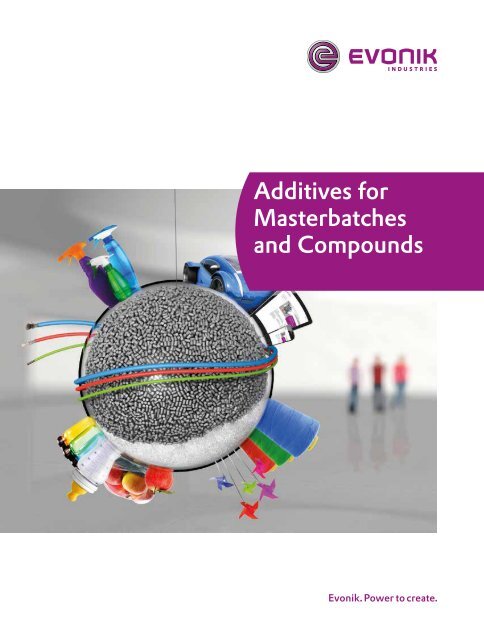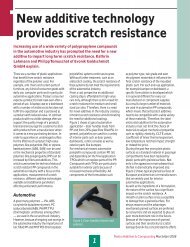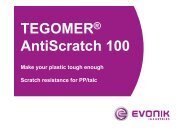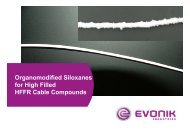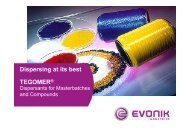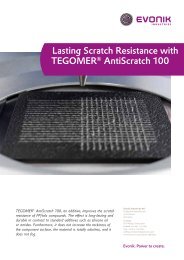Additives for masterbatches and compounds - Plastic Additives
Additives for masterbatches and compounds - Plastic Additives
Additives for masterbatches and compounds - Plastic Additives
You also want an ePaper? Increase the reach of your titles
YUMPU automatically turns print PDFs into web optimized ePapers that Google loves.
<strong>Additives</strong> <strong>for</strong><br />
Masterbatches<br />
<strong>and</strong> Compounds
Contents<br />
1 Multifunctional <strong>Additives</strong> <strong>for</strong> the<br />
<strong>Plastic</strong>s Industry<br />
2 Organomodified Siloxanes -<br />
Per<strong>for</strong>mance <strong>Additives</strong><br />
3 Benefits of OMS as <strong>Plastic</strong> Additive<br />
4 Examples <strong>for</strong> the Benefits of OMS <strong>Additives</strong><br />
6 Dispersing <strong>Additives</strong> <strong>for</strong> Pigments <strong>and</strong> Fillers<br />
7 Benefits of our Products in different<br />
Dispersing Applications<br />
9 Specialty Additive - TEGO Sorb<br />
11 Base <strong>Additives</strong><br />
12 Inhouse Evaluation Technologies<br />
2
Multifunctional <strong>Additives</strong><br />
<strong>for</strong> the <strong>Plastic</strong>s Industry<br />
Our technical expertise, market insight <strong>and</strong> new ideas enable us to cope with the<br />
increasing dem<strong>and</strong>s of the plastics industry. We offer a broad range of additives <strong>for</strong><br />
various applications of plastics, e.g. OMS based per<strong>for</strong>mance additives to improve<br />
surface <strong>and</strong> bulk properties of polymers like scratch resistance, surface smoothness or<br />
processing parameter; dispersing additives <strong>for</strong> pigments <strong>and</strong> fillers; the specialty<br />
additive TEGO® Sorb; <strong>and</strong> base additives like anti-fogging <strong>and</strong> antistatic additives.<br />
3
1. Organomodified Siloxanes –<br />
Per<strong>for</strong>mance <strong>Additives</strong><br />
Optimized Combinations <strong>for</strong> Best Per<strong>for</strong>mance<br />
Organomodified siloxanes (OMS) are<br />
used during the production of polymeric<br />
materials as processing additives <strong>for</strong> extrusion,<br />
injection <strong>and</strong> blow molding. They<br />
are capable to function as compatible internal<br />
slip <strong>and</strong> release agents. Additionally,<br />
these specialties can be applied as surface<br />
modifying agents or material property<br />
enhancers by permanent implementation<br />
<strong>for</strong> thermoplastics <strong>and</strong> elastomeric polymers.<br />
There<strong>for</strong>e, they are utilized in wide<br />
spread applications such as in automotive<br />
parts, domestic <strong>and</strong> consumer goods.<br />
Organomodified siloxanes consist of a<br />
siloxane backbone with attached organic<br />
groups. The organic groups ensure a<br />
permanent functionalization of the polymer<br />
without bleeding of the OMS. Different<br />
molecular architectures of OMS<br />
derivatives are available. Figure 1 shows<br />
the comb-like as well as the linear structure<br />
of the OMS together with the possible<br />
functional groups.<br />
By varying the density <strong>and</strong> nature of the<br />
attached organic groups the OMS called<br />
TEGOMER® or TEGOPREN® are tailor<br />
made products to the final application.<br />
Figure 2 shows the functionalization of<br />
a polymer matrix with OMS. These derivatives<br />
can either work <strong>for</strong> bulk modification<br />
(case A) or <strong>for</strong> surface modification<br />
(case B).<br />
comb-like<br />
OMS<br />
linear<br />
Polymer<br />
Methylgroup<br />
Organic Substituents<br />
Silicon<br />
• Alkyl<br />
Oxygen<br />
• Epoxide<br />
• Hydroxy<br />
A<br />
B<br />
• Amino<br />
• Carboxyl<br />
• Acrylate<br />
Figure 1: Structures of organomodified siloxanes<br />
Figure 2: Anchorage of an OMS by organic side chains<br />
4
Benefits of OMS as <strong>Plastic</strong> Additive<br />
OMS influence <strong>and</strong> improve the production<br />
process of a plastic product as well<br />
as the properties of the final product.<br />
The table summarizes the benefits of<br />
OMS with regard to the processing, the<br />
modification of the surface <strong>and</strong> the properties<br />
of the final plastic product.<br />
Processing<br />
Surface<br />
modification<br />
• Rheology of polymer melt<br />
• Improved mold fill operation<br />
• Suppression of melt fracture<br />
• Improved mold release<br />
• Increased productivity<br />
• Lubrication<br />
• Higher filler content<br />
• Improved scratch resistance<br />
• Suppression of shark skin<br />
• Lowered surface roughness<br />
• Improved chemical resistance<br />
• Improved water resistance<br />
Material property<br />
enhancer<br />
• Improved impact strengh<br />
• Reduced brittleness<br />
• Higher plasticity<br />
• Higher elongation<br />
• Enhanced flame resistance<br />
• Improved low temperature stability<br />
• Improved heat distortion temperature<br />
5
Examples <strong>for</strong> the Benefits<br />
of OMS <strong>Additives</strong><br />
Effect on Scratch Resistance<br />
Scratch <strong>and</strong> mar resistance are important<br />
issues <strong>for</strong> automotive application, domestic<br />
appliance <strong>and</strong> the furniture industry.<br />
They can be evaluated by different methods<br />
mainly developed by the automotive industry.<br />
Figure 3 shows the effect of the<br />
organomodified siloxane TEGOMER®<br />
AntiScratch 100 with 2 % addition evaluated<br />
by Erichson methods (GM 10640) in<br />
a PP talc compound. In this case, the<br />
damage of the surface measured as Delta<br />
L* value (change of brightness value of<br />
the scratched to the none-scratched<br />
plate) will be reduced significantly.<br />
Figure 3: Improvement of scratch resistance by using OMS derivatives<br />
left: Pure compound; right: 2 % TEGOMER® AntiScratch 100 applied to the compound<br />
Effect on Melt Flow Index (MFI)<br />
The positive influence of OMS additives<br />
on the viscosity can be shown by MFI determination<br />
as well as by melt flow path<br />
evaluation. Our technical department is<br />
equipped with an injection moulding tool<br />
to determine the influence on melt flow<br />
behavior. For example the addition of<br />
2 % TEGOMER® H-Si 6440 P to a PBT<br />
compound leads to an improvement of<br />
25 % of the melt flow length (Figure 4).<br />
Figure 4: Improvement of melt flow path by TEGOMER® H-Si 6440 P<br />
Melt flow path (cm) St<strong>and</strong>ard PBT without OMS 2 % TEGOMER® H-Si 6440 P in PBT<br />
50<br />
45<br />
40<br />
35<br />
30<br />
25<br />
20<br />
0<br />
6
Effect on Flame Resistance<br />
Figure 5: Highly filled cable compound with <strong>and</strong> without TEGOMER® FR 100<br />
Flame resistance is an issue of high consideration<br />
<strong>for</strong> a variety of new compound developments<br />
used in cable jacketing materials<br />
<strong>for</strong> building <strong>and</strong> transportation as well<br />
as <strong>for</strong> electronics. OMS additives improve<br />
in halogen free flame retardant EVA <strong>compounds</strong><br />
die drol <strong>and</strong> throughput. Additionally<br />
it allows fillings up to 65 % of ATH<br />
or MDH finally resulting in highest flame<br />
resistance. Figure 5 illustrates the effect<br />
of 2 % of TEGOMER® FR 100 in a cable<br />
compound with 65 % ATH.<br />
Positive side effects of Evonik additives: kinking in<br />
the cable str<strong>and</strong>, which can complicate the drawing<br />
of cables over long distances as in multistory buildings,<br />
does not occur. Additionally, the continuous<br />
printing of the cable that is necessary is not negatively<br />
impacted as in the case of other additives<br />
such as cheap silicone oils.<br />
7
2. Dispersing <strong>Additives</strong> <strong>for</strong> Pigments <strong>and</strong> Fillers<br />
Stabilizing with Know-how<br />
Evonik Industries offers under the trade<br />
name TEGOMER® <strong>and</strong> TEGOPREN® dispersing<br />
agents <strong>for</strong> fillers <strong>and</strong> pigments.<br />
They are invaluable in achieving the optimized<br />
distribution of fillers or inorganic<br />
pigments in <strong>compounds</strong> as well as the dispersion<br />
of organic pigments in color concentrates<br />
like <strong>masterbatches</strong> <strong>and</strong> liquid<br />
pastes.<br />
As a result of their polar surfaces most organic<br />
pigments are not compatible in non-polar<br />
or less polar matrices, e. g. PE, PP, PA,<br />
PET etc. Such particles tend to <strong>for</strong>m agglomerates<br />
that are big enough to influence<br />
the overall per<strong>for</strong>mance of the final polymer<br />
or the masterbatch <strong>for</strong>mulation. This<br />
behavior causes some undesired effects.<br />
Dispersing additives help to cover the<br />
newly <strong>for</strong>med surface of the aggregates<br />
<strong>and</strong> primary particles during the dispersing<br />
process. Aggregates which are<br />
covered with the dispersing additive<br />
cannot agglomerate anymore. Moreover,<br />
they become compatible to the matrix<br />
by the polymer chains attached to the dispersing<br />
additive (Figure 6).<br />
Our products are essential ingredients to:<br />
• Improve development of color<br />
• Prevent clogging of filter sieves<br />
• Avoid blocking of spinning nozzles<br />
• Manufacture fibres without<br />
capillary fractures<br />
• Reduce speck <strong>for</strong>mation within films<br />
or thin walled parts<br />
• Increase productivity or to reduce<br />
maintenance ef<strong>for</strong>ts<br />
• Avoid bleeding of pigments<br />
• Cannot only be used <strong>for</strong> polyolefins but<br />
even <strong>for</strong> engineering resins<br />
Agglomerates<br />
TEGOMER®<br />
Aggregates<br />
Figure 6: Break of agglomerates <strong>for</strong> development of color intensity<br />
8
Benefits of our Products<br />
in different Dispersing Applications<br />
Coloration<br />
of Masterbatches<br />
Pigment & Filler<br />
Treatment<br />
• Improvement of color strength<br />
• Application in polyolefines <strong>and</strong> engineering plastics<br />
• Easy processable <strong>masterbatches</strong><br />
• Higher pigment loading<br />
• Easy processing without bleeding<br />
• Reduced filter pressure index<br />
• High filler or pigment loading<br />
• Easy dispersing process<br />
• Easy processing of <strong>masterbatches</strong><br />
• No restrictions in final application (e. g. sealing, printing)<br />
• Higher bulk density<br />
Liquid Pastes<br />
<strong>for</strong> Coloration<br />
• High pigment loading<br />
• Improved color strength in <strong>compounds</strong><br />
• Low viscosities of pastes<br />
• Prevention of settlement<br />
9
Our customers can expect technical advice<br />
due to the large number of trials carried<br />
out in our laboratories using different<br />
pigments <strong>and</strong> polymers <strong>for</strong> the<br />
manufacture of <strong>masterbatches</strong>. Guiding<br />
<strong>for</strong>mulations allow customers an easy<br />
start together with our knowledge regarding<br />
the resulting rheology effects.<br />
As an example the effect of 10 %<br />
TEGOMER® P 121 in a PA masterbatch<br />
with pigment Green 7 is shown in Figure 7.<br />
By using the additive TEGOMER® P 121<br />
the color strength is increased by 54 %<br />
<strong>and</strong> the pressure is reduced dramatically<br />
from 6.9 to 0.6 bar/g. That allows even<br />
the use <strong>for</strong> fibre <strong>and</strong> film application.<br />
Figure 7: Increased color strength <strong>and</strong> reduced pressure<br />
by TEGOMER® P 121<br />
Color<br />
strenght<br />
[%] 0 % 10 %<br />
160 8<br />
150<br />
154<br />
7<br />
140 6<br />
130 5<br />
120 4<br />
110 3<br />
100 100<br />
2<br />
90 1<br />
80 0<br />
Pressure<br />
index<br />
[bar/g] 0 % 10 %<br />
6.9<br />
0.6<br />
In-house Evaluation Technologies<br />
<strong>for</strong> Dispersants<br />
Dispersing <strong>and</strong> wetting of pigments are<br />
core competences of Evonik.<br />
Our laboratories are able to per<strong>for</strong>m a<br />
multitude of test methods which are<br />
important st<strong>and</strong>ards of the industry.<br />
We have the following test methods inhouse<br />
available.<br />
Evaluated property Test method/equipment<br />
Color strength<br />
Full shade <strong>and</strong> tinted systems with Datacolor equipment<br />
Speck evaluation Microscopic evaluation on 50 micrometer plates or on film samples<br />
Pressure index Brabender equipment, e. g. DIN EN 13900-5<br />
Polymer rheology Melt flow index determination or Anton Paar Viscosimeter<br />
10
3. Specialty Additive – TEGO® Sorb<br />
Giving the World a Clean Smelling Back<br />
In addition to OMS based per<strong>for</strong>mance<br />
additives <strong>and</strong> dispersing additives<br />
we offer a specialty additive <strong>for</strong> odor<br />
absorption.<br />
Odor absorbers offer the solution to avoid<br />
undesired odors in polymer applications.<br />
The excellent odor absorbing properties<br />
of TEGO® Sorb enables the effective control<br />
of odors envolving from pigments,<br />
polymers, <strong>compounds</strong> or <strong>masterbatches</strong>.<br />
Typical odor creating substances are hydrogen<br />
sulphide, mercaptane, amines <strong>and</strong><br />
others which will be covered by TEGO®<br />
Sorb. Also the odor absorbers prevent the<br />
emission from recycling polymers, ultramarineblue<br />
pigment <strong>masterbatches</strong>, TPEs,<br />
PA <strong>and</strong> others.<br />
For the automotive industry in particular<br />
the application of our products is of main<br />
importance since it effectively provides<br />
a way to manage the odor in the interior<br />
of the car.<br />
The film industry <strong>and</strong> manufacturers<br />
of caps <strong>for</strong> bottles are the end users with<br />
critical organoleptic requests where<br />
TEGO® Sorb helps to meet those requirements.<br />
11
Chemically TEGO® Sorb is a zinc ricinoleate<br />
whereby the central metal zinc ion is<br />
capable to bind malodor causing components.<br />
Figure 8 shows the chemical structure<br />
of TEGO® Sorb as well as a computer<br />
model of the molecule.<br />
TEGO® Sorb is compatible to polyolefines<br />
<strong>and</strong> technical polymers. A concentration<br />
between 0.5 <strong>and</strong> 2.0 % is sufficient to reduce<br />
the malodor significantly. As an example<br />
the reduced emission of sulphur<br />
<strong>compounds</strong> from recycled Polyamide 6 is<br />
shown in Figure 9.<br />
Test setup<br />
• Polymer: Recycled Polyamide 6<br />
• Odor absorber: 1 % TEGO® Sorb<br />
• Measurement: VOC thermo desorption<br />
(VDA Norm 278)<br />
The benefits of TEGO® Sorb can be<br />
identified in the following manufacturing<br />
steps:<br />
• during production to guarantee an<br />
environment free of malodor<br />
• <strong>for</strong> reduced odor of the final product<br />
• especially to eliminate malodor of<br />
recycling materials or in rubber<br />
production<br />
Figure 9: Reduction of hydrogen<br />
sulfide <strong>and</strong> mercapto methane by<br />
TEGO® Sorb<br />
Relative<br />
GC units<br />
140<br />
120<br />
100<br />
80<br />
60<br />
40<br />
20<br />
0<br />
No<br />
additives<br />
1 %<br />
TEGO®<br />
Sorb<br />
Figure 8: Molecular structure of TEGO® Sorb<br />
MeSH<br />
H 2<br />
S<br />
12
4. Base <strong>Additives</strong><br />
Still necessary <strong>for</strong> Making <strong>Plastic</strong>s Working<br />
Antifogging <strong>Additives</strong><br />
Fogging results from the condensation of<br />
water as small discrete droplets on the<br />
surface of transparent plastic films. They<br />
can be avoided by the use of those antifogging<br />
additives. In greenhouses the water<br />
droplets can act like small lenses <strong>and</strong><br />
damage plants leaves. In food packaging<br />
droplet <strong>for</strong>mation leads to unfavourable<br />
appearance <strong>and</strong> may cause food spoilage.<br />
TEGO® STS used as antifogging additives<br />
acts as surface active or wetting agent <strong>and</strong><br />
prevents the <strong>for</strong>mation of discrete water<br />
droplets by building a continuous water<br />
film. TEGO® STS is often used in combination<br />
with TEGOMER® P 121 or P 122 in<br />
<strong>masterbatches</strong>.<br />
Antistatic Agents<br />
Antistatic agents offer a solution against<br />
negative effects related to electrostatic<br />
charges like attraction of dust on plastic<br />
part surfaces or static discharge.<br />
TEGIN® 90 Pellets an antistatic agent can<br />
be incorporated in the final production<br />
step of basic polymers or in <strong>masterbatches</strong><br />
<strong>and</strong> <strong>compounds</strong>. It migrates to the surface<br />
of the polymer film or part. In combination<br />
with atmospheric humidity a conductive<br />
film is <strong>for</strong>med on the surface of the<br />
polymer, which is necessary to dissipate<br />
the charge.<br />
13
5. Inhouse Evaluation Technologies<br />
Our technical service – an offer <strong>for</strong> you<br />
Evaluated property<br />
Scratch <strong>and</strong> mar resistance<br />
MFI properties <strong>and</strong> viscosity<br />
Test method/equipment<br />
Erichsen Scratch tester, e. g. GM 10640,<br />
Five Finger Scratch test, Crockmaster<br />
Melt flow path, Melt flow index by DIN 1133 or ASTM D 1238,<br />
Anton Paar viscosimeter up to 400 °C<br />
Flame retardence<br />
Impact test<br />
Notched impact test<br />
UL94 evaluation, low oxygene index<br />
Izod <strong>and</strong> Charpy method at room temperature<br />
<strong>and</strong> at low temperature between -20 °C <strong>and</strong> -40 °C<br />
Tensile strength, elongation<br />
Zwick machine<br />
Shark skin<br />
Blow film line from Brabender<br />
COF modification e. g. DIN EN ISO 8295<br />
Gloss <strong>and</strong> color evaluation Datacolor, e.g. DIN EN ISO 2813 <strong>and</strong> 5033<br />
14
www.evonik.com/plastic-additives<br />
For more detailed in<strong>for</strong>mation or to obtain a brochure<br />
which addresses a specific area of interest, please visit<br />
our website.<br />
This in<strong>for</strong>mation <strong>and</strong> all further technical advice is<br />
based on our present knowledge <strong>and</strong> experience.<br />
However, it implies no liability or other legal responsibility<br />
on our part, including with regard to existing<br />
third party intellectual property rights, especially patent<br />
rights. In particular, no warranty, whether express<br />
or implied, or guarantee of product properties in the<br />
legal sense is intended or implied.<br />
We reserve the right to make any changes according<br />
to technological progress or further developments.<br />
The customer is not released from the obligation to<br />
conduct careful inspection <strong>and</strong> testing of incoming<br />
goods. Per<strong>for</strong>mance of the product described herein<br />
should be verified by testing, which should be carried<br />
out only by qualified experts in the sole responsibility<br />
of a customer. Reference to trade names used by other<br />
companies is neither a recommendation, nor does it<br />
imply that similar products could not be used.<br />
(April 2008)<br />
Europe | Middle East | Africa<br />
Evonik Industries AG<br />
Goldschmidtstraße 100<br />
45127 Essen<br />
Germany<br />
Phone +49 201 173-2665<br />
fax +49 201 173-1990<br />
Asia | Pacific<br />
Evonik Degussa<br />
Specialty Chemicals Co, Ltd.<br />
55, Chundong Road<br />
Xinzhuang Industry Park<br />
Shanghai, 201108<br />
PR China<br />
Phone +86 21 6119-1125<br />
fax +86 21 6119-1406<br />
The Americas<br />
Evonik Goldschmidt Corp.<br />
914 E. R<strong>and</strong>olph Rd.<br />
P.O. Box 1299<br />
Hopewell, VA 23860<br />
USA<br />
Phone +1 804 541-8658<br />
fax +1 804 541-2783<br />
09/2013 Inv.-Nr.: 35-13


